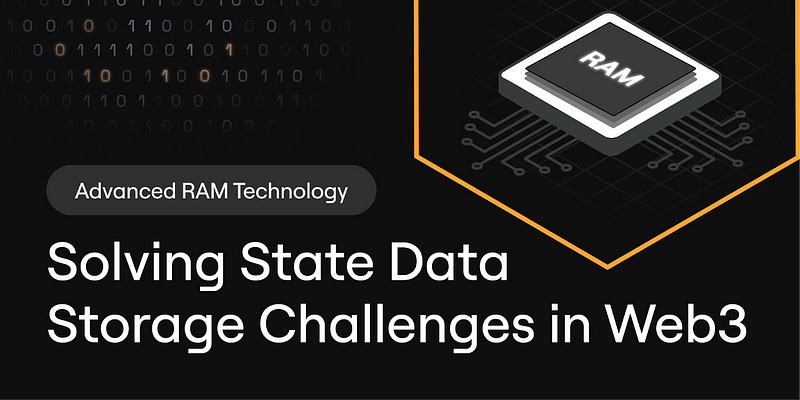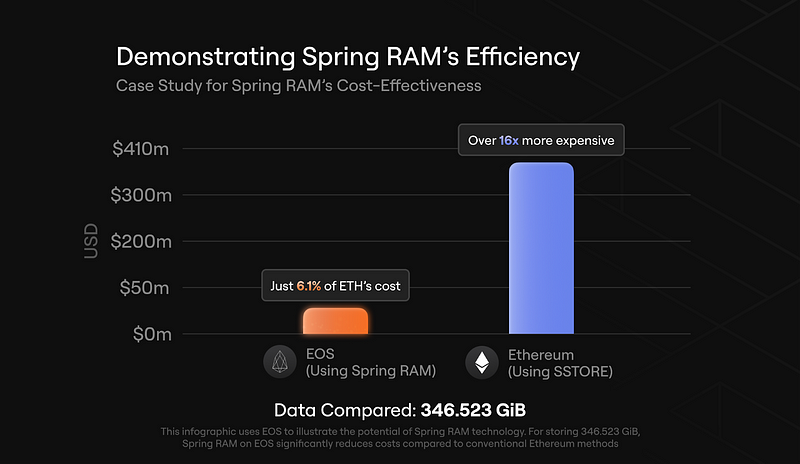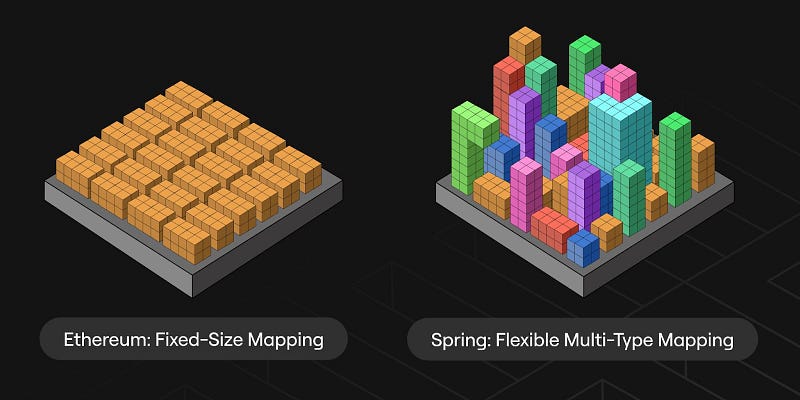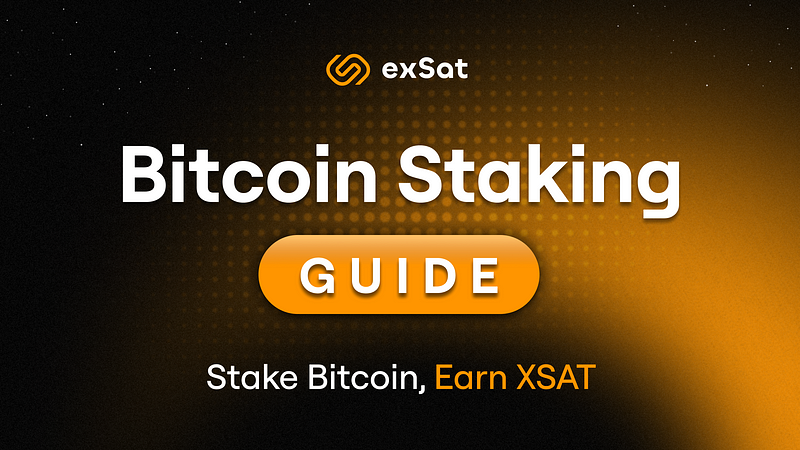
At exSat, we face the critical challenge of managing vast amounts of state data efficiently and cost-effectively in a decentralized environment. Traditional blockchain models often struggle with scalability, performance, and state data management, resulting in inefficiencies and high costs. This is particularly relevant for our project, which requires robust state data handling capabilities. Spring, with its advanced RAM implementation, provides a solution that meets these specific needs.
Practical Foundations for Enterprise Use
Spring was designed to support complex and large-scale applications. Its design choices are inspired by real-world demands for scalability, performance, and security. A critical aspect of this design is the unique implementation of RAM, which is structured to handle large-scale applications and state data-intensive processes efficiently. This capability is essential for exSat, ensuring that our data management needs are met effectively and sustainably.
Technical Innovations Driven by Practicality
The innovative approach to on-chain storage and state data management in Spring is a significant advancement. By optimizing how RAM is used, the protocol allows for efficient state data handling and storage solutions, directly addressing the performance bottlenecks common in traditional and early blockchain systems. This flexibility enhances performance and reduces operational costs, making it an ideal fit for the exSat project’s demanding requirements. This optimization creates a system capable of running enterprise applications efficiently, bridging the gap between traditional IT infrastructure and blockchain technology.
Aligning Blockchain with Business Needs
Springs’s practical orientation extends to its overall architecture, built to support the nuanced requirements of enterprise operations. Its advanced RAM capabilities play a significant role in this alignment, offering scalable, secure, and cost-efficient state data storage solutions superior to traditional databases and other blockchain technologies. This alignment makes Spring particularly well-suited for the exSat project.
Exploring RAM’s Unique Properties
The strategic advantages of Spring, particularly its innovative RAM technology, are central to meeting exSat’s needs. In the following sections, we will explore the unique properties of RAM within Spring and how these innovations address the specific challenges of our project. By leveraging these advanced capabilities, we aim to demonstrate how RAM technology can drive efficiency and scalability in decentralized applications, positioning our project at the forefront of blockchain innovation.

Advantages of Using Spring RAM for State Data Storage
Scalability Without Loss of Security
Spring RAM uniquely combines scalability with robust security features, positioning it as a superior choice for state data storage on the blockchain. Unlike traditional databases or other blockchain systems like Bitcoin, which lack flexible on-chain storage, Spring RAM provides the ability to scale efficiently without compromising on security. This is crucial for applications requiring large-scale state data management while maintaining high security standards.
Performance Enhancements
Spring introduces an abstraction layer in its on-chain storage definition, which facilitates significant software-side optimizations. This design allows the system to seamlessly adapt to new advancements in hardware and software, thereby enhancing overall performance.
Cost Efficiency
Through strategic optimizations and engineering innovations, Spring has enhanced its cost efficiency. Features such as RAM refund mechanisms for on-chain accounts not only reduce operational costs but also promote greater economic feasibility for developers and businesses. This cost reduction translates into broader decentralization and redundancy, making it economically viable to have more nodes holding the state data.
Flexible and Advanced Data Handling
In contrast to Ethereum’s low-level storage system defined by the Ethereum Virtual Machine (EVM), which imposes rigid data sizing and mapping, Spring employs a high-level approach. This approach provides flexible mapping and addressing modes that can store large data sets more naturally and efficiently. It simplifies storage and retrieval processes, accommodating diverse data types and sizes.
Meeting Current and Future Needs
By focusing on scalability, performance, cost efficiency, and flexible data handling, Spring RAM not only meets the current needs of businesses but also anticipates future demands. This forward-thinking approach ensures that Spring remains at the forefront of blockchain technology, providing tangible benefits to users and developers alike.

Spring RAM: Leading Through Adaptability and Advanced Design
Existing Blockchain Limitations
Many existing blockchain protocols are constrained by their initial design decisions concerning state data storage. Once these protocols are set, they often become difficult to change due to architectural limitations, political consensus issues, and a tendency towards ossification. This rigidity can hinder their ability to adapt to new technological advancements or evolving market needs.
Potential for New Blockchain Entrants
While technically possible, new blockchains entering the market to compete with established protocols face significant challenges. The network effect — where the value of a service increases with the number of its users — creates a high barrier to entry. Simply being adequate is not enough; a new blockchain must offer distinct advantages to overcome established players.
Spring’s Scalability and Flexibility
Spring stands out with its scalability-first architecture, designed to efficiently scale both vertically and horizontally. This design philosophy ensures that Spring can leverage new hardware advancements, providing continual improvement in performance and capability.
Flexible API for Data Indexing and Access
Spring offers a flexible API that facilitates effective state data indexing and access, setting it apart from other blockchains that may have more rigid data handling capabilities. This flexibility is crucial for developers who need to implement complex data structures or require efficient data retrieval methods.
Meeting Current and Future Needs
By focusing on adaptability and advanced design, Spriing RAM not only addresses the limitations faced by many existing blockchains but also positions itself as a leader in blockchain innovation. These characteristics make Spring an attractive framework for developers and enterprises looking to utilize blockchain technology in practical and scalable ways.
Future Directions: Advancing Spring RAM Technology
Introducing State Proofs
State proofs are set to revolutionize the way Spring handles data verification, significantly enhancing the protocol’s capabilities across several dimensions:
- Enhanced Light Client Support: By enabling secure and efficient verification without needing full blockchain data, state proofs will make Spring more accessible for users with limited resources. This enhancement is crucial for expanding the usability of Spring in diverse environments.
- Facilitates Side Chains and Interoperability: State proofs will improve integration with side chains, enhancing Spring’s ability to interact seamlessly with other blockchains. This fosters a more interconnected blockchain ecosystem, which is vital for the broad adoption of blockchain technology.
- Improves RAM Leasing and State Leasing: The introduction of state proofs is expected to support more secure and decentralized markets for leasing blockchain resources, making it easier and safer for users to engage with these services.
- Enhances Trust and Security: By minimizing reliance on trusted third parties, state proofs will enhance the overall integrity and security of Spring, making it a more robust protocol for all users. This feature supports enhanced light client capabilities, side chains, and improved interoperability with other blockchains.
RAM Leasing: Greater Efficiency and Scalability
The evolution of RAM leasing in Spring is anticipated to bring about greater efficiency and scalability. This development will address current and future demands by optimizing how resources are allocated and managed within the ecosystem.
Looking Ahead
As Spring continues to evolve, in particular with the forthcoming release of Spring 1.0, the focus remains on enhancing the technological foundation to meet emerging challenges and opportunities. The advancements in state proofs and RAM leasing are just the beginning. Future developments might include more advanced consensus mechanisms, integration of artificial intelligence for network management, and further enhancements to the scalability and efficiency of the system. By continuing to focus on these key areas, Spring aims to maintain and extend its lead in blockchain technology, ensuring that it remains at the cutting edge of enterprise solutions.
At exSat, we are poised to leverage these advancements to improve our data management capabilities, enhance security, and reduce operational costs. By utilizing Spring’ advanced RAM technology, we can bridge the gap between Bitcoin’s trust and enhanced functionality, ensuring that our Layer 1.5 scaling solution unlocks the full potential of the Bitcoin ecosystem. This robust, scalable, and efficient foundation will support our current needs and position us to take advantage of future innovations in blockchain technology.

